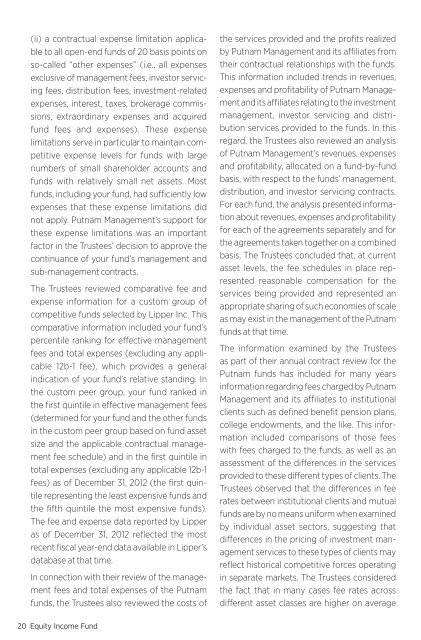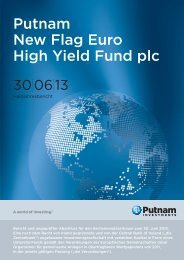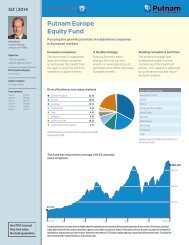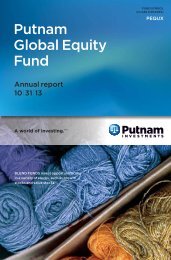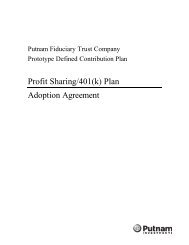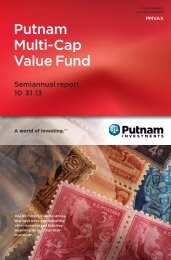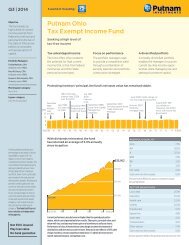Equity Income Fund Annual Report - Putnam Investments
Equity Income Fund Annual Report - Putnam Investments
Equity Income Fund Annual Report - Putnam Investments
Create successful ePaper yourself
Turn your PDF publications into a flip-book with our unique Google optimized e-Paper software.
(ii) a contractual expense limitation applicableto all open- end funds of 20 basis points onso- called “other expenses” (i.e., all expensesexclusive of management fees, investor servicingfees, distribution fees, investment- relatedexpenses, interest, taxes, brokerage commissions,extraordinary expenses and acquiredfund fees and expenses). These expenselimitations serve in particular to maintain competitiveexpense levels for funds with largenumbers of small shareholder accounts andfunds with relatively small net assets. Mostfunds, including your fund, had sufficiently lowexpenses that these expense limitations didnot apply. <strong>Putnam</strong> Management’s support forthese expense limitations was an importantfactor in the Trustees’ decision to approve thecontinuance of your fund’s management andsub-management contracts.The Trustees reviewed comparative fee andexpense information for a custom group ofcompetitive funds selected by Lipper Inc. Thiscomparative information included your fund’spercentile ranking for effective managementfees and total expenses (excluding any applicable12b- 1 fee), which provides a generalindication of your fund’s relative standing. Inthe custom peer group, your fund ranked inthe first quintile in effective management fees(determined for your fund and the other fundsin the custom peer group based on fund assetsize and the applicable contractual managementfee schedule) and in the first quintile intotal expenses (excluding any applicable 12b- 1fees) as of December 31, 2012 (the first quintilerepresenting the least expensive funds andthe fifth quintile the most expensive funds).The fee and expense data reported by Lipperas of December 31, 2012 reflected the mostrecent fiscal year- end data available in Lipper’sdatabase at that time.In connection with their review of the managementfees and total expenses of the <strong>Putnam</strong>funds, the Trustees also reviewed the costs ofthe services provided and the profits realizedby <strong>Putnam</strong> Management and its affiliates fromtheir contractual relationships with the funds.This information included trends in revenues,expenses and profitability of <strong>Putnam</strong> Managementand its affiliates relating to the investmentmanagement, investor servicing and distributionservices provided to the funds. In thisregard, the Trustees also reviewed an analysisof <strong>Putnam</strong> Management’s revenues, expensesand profitability, allocated on a fund- by- fundbasis, with respect to the funds’ management,distribution, and investor servicing contracts.For each fund, the analysis presented informationabout revenues, expenses and profitabilityfor each of the agreements separately and forthe agreements taken together on a combinedbasis. The Trustees concluded that, at currentasset levels, the fee schedules in place representedreasonable compensation for theservices being provided and represented anappropriate sharing of such economies of scaleas may exist in the management of the <strong>Putnam</strong>funds at that time.The information examined by the Trusteesas part of their annual contract review for the<strong>Putnam</strong> funds has included for many yearsinformation regarding fees charged by <strong>Putnam</strong>Management and its affiliates to institutionalclients such as defined benefit pension plans,college endowments, and the like. This informationincluded comparisons of those feeswith fees charged to the funds, as well as anassessment of the differences in the servicesprovided to these different types of clients. TheTrustees observed that the differences in feerates between institutional clients and mutualfunds are by no means uniform when examinedby individual asset sectors, suggesting thatdifferences in the pricing of investment managementservices to these types of clients mayreflect historical competitive forces operatingin separate markets. The Trustees consideredthe fact that in many cases fee rates acrossdifferent asset classes are higher on average20 <strong>Equity</strong> <strong>Income</strong> <strong>Fund</strong>


